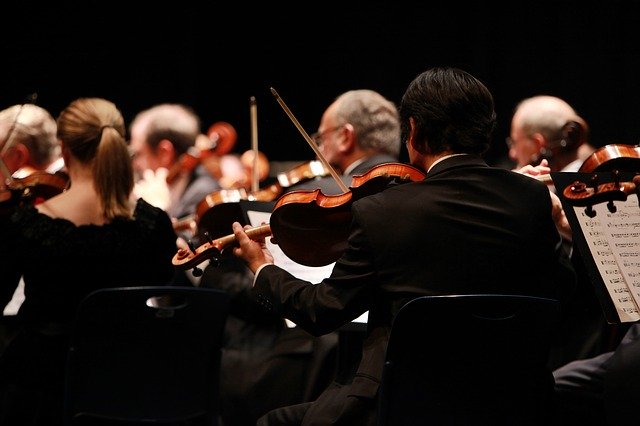
The Storytelling Power of Music in ‘Game of Thrones’
When critiquing the narrative beats of a particular film or television program, it is not uncommon to see people approaching the plot as though it were a book. This entails solely criticizing the writing from a mechanical standpoint, which denominates several factors that feed into the narrative of the film, which includes shot composition, editing and music.
Alfred Hitchcock once described the structure of a scene as being akin to musical composition: there are many instruments at work that pitch various tones with notes that are individually weak but combine into a cohesive whole that tells a musical story. It is the “size,” the prominence, of these individual factors which comprise a psychological effect on the spectator, eliciting an emotional reaction.
Hitchcock’s metaphor applies to the whole of filmmaking, especially the music and its utilization. While the average Joe might not consciously pick up on the subtleties of such expression, their brain does. In this essay, I will be using HBO’s Game of Thrones, which despite not being a film exhibits similar qualities to one, to examine how its usage of musical scores is layered in the narrative to create powerful scenes.
Music is a facet of filmmaking often overlooked in the realm of criticism, written off as little more than a mood-enhancer that, while a viable tool to emotionally engage the audience with, possesses little importance in the way of plot advancement. That’s not to say there is none at all, but this mindset discredits the power music can have.
‘Film Music and Film Genre’, a thesis was written by Mark Brownwigg, concludes this belief as widespread after much research and finding little scholarly material about the topic. His argument, like mine, is made to dissuade such beliefs, and disproves the supposed irrelevance of film music, citing, “‘music is used to complement (sic) the psychological states of the characters,’ as if it doesn’t do this anywhere else” (pg. 10).
The author Brownwigg cites is arguing that this is only prevalent in the Noir genre, that it serves no further purpose, and its role in narrative development only warrants a passing mention. We both argue that music does much more, that it plays a key role in emotionally manipulating viewers into feeling how the director intends for them to feel.
Akin to the information it conveys on a character’s psychological state, music offers viewers an intimate experience in gauging the “feeling” a character is meant to convey to the audience. It works as a frame that coincides with the images onscreen, particularly within HBO’s ‘Game of Thrones’, for example.
The adaptation of George R.R. Martin’s ‘A Song of Ice and Fire’ entails an epic narrative spanning across a multitude of branching storylines that have ripple effects on one another, all while boasting a Simpsons-sized cast of characters.
With such a large scope, the story has to take extra care and time conveying what it needs to about its many players. One way it achieves this is through the usage of leitmotifs, theme music, each of them unique in their composition and overall mood, and are skillfully used throughout the series as a way of characterizing specific story beats.
The characters are divided by their “Houses,” the families, who on a thematic level entail specific ideologies about human behavior which are emphasized by the nature of the according families. This is reflected in the leitmotifs.
For example, the honorable protagonists of the series, House Stark, are kicked to the ground time and again by others who abuse their trusting nature for political gain. Patriarch Eddard Stark (spoiler alert) is decapitated at the series’ beginning when trying to spare his children from horrible fates after being told they would be shown mercy if he dismisses his claims that would incriminate the ruling family.
His admittedly foolish decision prior, though driven by honor, is not seen as such by the short-tempered boy-king he’d slandered, who punishes him for his insolence. The subsequent drama and leitmotif are given form later, not by the act of a beloved protagonist suddenly dying, but by the reaction of his family.
Brownwigg uses the phrase “melodrama” to encapsulate this idea, where both the nineteenth century and modern definitions entail it to be romanticized drama characterized by the emotion and actions of a particular body of work. The former definition once included music, but no longer. He argues the power music has is still equally as present.
Brownwigg summarizes his argument, that is the place music has in conveying drama to the audience, in rather simple terms: “A simple commutation test demonstrates the romantic resonance of string instruments and piano; if… playing tuba and drums, the effect of their scenes together would have been quite different, and the same goes for the piano and cello match,” (pg. 156).
In essence, it is not solely the power of a composition that is important – it’s the music itself that frames the narrative in a specific emotion.
(Article continues below ad)
Sponsored Ad
In the case of the Stark characters, their framing is a somber one. The emotion of their story and accompanying theme elicits are crafted to characterize the family in the hearts of audiences. The Stark family faces great tragedy, and their theme music is made to convey this feeling to the audience. Their leitmotif is slow, drawn-out by long, deep drags of a bowstring upon a cello. It swells midway in volume and composition, becoming a song of pure melancholy that doesn’t stop or lessen, it grows, just as the tragedy of the family never stops, it only worsens.
This piece characterizes key moments across the series, such as the family grieving in light of Eddard’s death, marking the first of many tragedies to come as well as the first instance of this music. It begins by following the stony face of now-widowed Catelyn Stark, whose men bow to her in solemn respect to their family. The swell of the piece begins as soon as she is distant to the camp, where she releases her pent up emotion and collapses against a tree, sobbing.
This composition occurs again as the remaining boys leave their burning home at the end of season two, and many times more, particularly amidst a mutiny of the biologically distant, albeit Stark-at-heart, Jon Snow. This instance is special, as it truly solidifies in the audience’s heart that, while a bastard, Jon is a Stark and died like one as well, whose family theme swells at the time his men part from his bleeding corpse and the camera pans upon it.
These moments cement their leitmotif in the audience’s mind to be associated with House Stark, and to associate with them as a tragedy. Whenever they hear it, it is surely accompanied by a backdrop to a time where the family is faced with a period of darkness, even when the piece is listened to on its own.
This cementing makes a later scene all the more powerful, where, after six seasons of betrayal and failure, the family finally gets the victory they have been cheated out of so many times, ironically through the manipulation of another.
The revived Jon and, at the time thought to be the sole surviving Stark, Sansa, choose to wage a desperate fight against the monstrous Boltons who betrayed their family. They look ready to lose their lives, as well as the hopeless battle when unexpected help comes in the form of master manipulator, Petyr Baelish.
If the story at this time were about him, his own theme might be playing. Instead, the camera focuses on the reactions of Jon, who is in relief and as much disbelief as the audience, as well as Sansa, looking grim, vengeful, and satisfied.
The melody of House Stark blares over the action, the sounds of battle almost entirely drowned out by its now-heavy drumming and angelic choir, with only the victorious warcry of an unexpected ally, Tormund Giantsbane, preceding the melody. The music here carries a triumphant feeling, a vibe that could bring an invested and attentive viewer to tears as the same thoughts run through their minds as they do the Stark siblings: “I cannot believe we’re actually going to win.”
Here, in this one moment, amidst a series full of despair, the Starks have achieved victory and revenge. Their revitalized theme reflects the gravity and beauty of this iconic moment. This is thanks to the composition and utilization of music, which adds an extra layer of emotion and character to an already intricate story.
Without this piece, if ‘Game of Thrones’ stripped these scenes of their music entirely, the Starks’ story would lose a component that lends a lot to their characters and their place in the narrative. The story and themes would remain the same, but the emotional beats would not hit as hard without the music. Without music, numerous moments characterized by music alone, such as their sole victory, loses much of their nuance.
This is equally as true with a certain character, one whose personal leitmotif is a part of the story as his very actions. It is as subtle and downplayed as the man it belongs to, and is similarly everywhere: that of Petyr “Littlefinger” Baelish.
In the narrative, Petyr is a man who serves everyone, yet no one but himself. His influence is felt throughout the plot, for he is the one who engineers its core conflicts and developments. He doesn’t make theatrics of his games, but instead plants ideas in others’ heads and then reaps the chaos. The presence of his own theme throughout the narrative epitomizes the idea that music can tell a story equally as much as plot progression.
This is agreed upon by the author of another thesis, ‘Affects and Feelings: The Persuasive Power of Film Music’, by Arroyo Garcia Lascurain.
At one point, he cites a naysayer who states, “[there is a] lack of narrative in film music itself… outlining how often the focus is ‘on the narrative and the visuals of the screen before us,” and “we forsake any consideration of […] music because it is nonrepresentational and non-narrative, and does not inhabit the perceptual foreground of the narrative film”, (pg. 12).
Petyr’s leitmotif stands as a testament against this claim, which acts as a narrative tool to characterize times where his influence is acted as early as the first episode of the series: the subtle keynotes of ‘Chaos is a Ladder’ chime in the background as Catelyn Stark burns a letter from her sister, which incriminates the rival family and chief source of conflict throughout the series as responsible for a crime they did not commit.
It is later revealed to have been fabricated by the whims of Littlefinger, who later murders Catelyn’s sister in a move to become acting ruler of her region. His only witness is young Sansa, whom he emotionally confused in the previous scene with a kiss and a false belief that he cares for her as he did her late mother.
This is capped off by an intense sequence where he murders Catelyn’s sister, his wife whom he’d said to love as much as her, only to tell her the only woman he will ever have feelings for is Catelyn. No room for substitutes like her or Sansa. The following credits, once more, utilize his unnerving theme.
Though occasionally on a piano, the melody this time is played on a similarly solitary and equally as eerie stringed instrument. It begins quietly, only to wind up more and more until its sound is overwhelming, like the ball of chaos Petyr himself engineers.
Lascurain explains the psychology behind the choice behind music implementations, citing the “tendency of audiences to use the score as a tool for understanding the meaning of other channels of information that makes film music so integral to the film-viewing experience. When using the music to help determine the meaning, the audience becomes less questioning, and more accepting, of what is happening on-screen,” (pg. 20).
In this instance, if the audience is at all confused by Petyr’s motivation behind this seemingly spur-of-the-moment decision, it should be cleared up by the return of his leitmotif, which was used exactly ten episodes prior in a scene which epitomizes his entire character: a monologue in which Littlefinger explains to another player of the proverbial game his view of the world, his distance from concepts like love, and how he uses them as a means of brewing chaos which he reaps the benefits from.
Lascurain explains the usage of music gives extra meaning to an onscreen action that the audience comes to recognize, whether it is subconsciously or not. With Petyr, even if they don’t immediately recall the usage of his theme or its subtle cropping up in similar scenes, their brains are likely to elicit the same emotional reaction as it has every other time: tension borne of uncertainty and fear.
As a result, the narrative power of music shines through in the way it is composed and implemented.
With the examples provided, it’s clear just how prominent and effective music is in shaping an audience’s perception of a story, and by proxy, their experience. Leitmotifs are a way of distinguishing characters and stories, and specific pieces can be used to deepen a narrative depending on their compositions and place in the story.
I consider Game of Thrones to be a monumental achievement in visual storytelling, and this but one of many aspects as to why. I conclude this essay hoping I have granted you a deeper respect for the work that goes into bringing Martin’s world to life and doing it justice.
Sources Cited
Arroyo Garcia Lascurain F. Affect and Feelings: The Persuasive Power of Film Music. 2016. https://escholarship.org/uc/item/4n1745zx. Accessed December 4, 2018.
Brownrigg Mark. Film Music and Film Genre. 2003.
https://core.ac.uk/download/pdf/40108516.pdf Accessed December 3, 2018.



